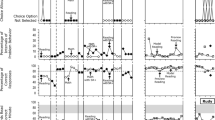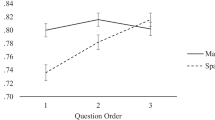Abstract
This study investigated the extent to which interspersing effects are consistent with the effects of reinforcement on predicting students’ preferences for mathematics assignments. Students were exposed to 4 pairs of assignments. Each assignment pair contained a control assignment with 15 problems requiring multiplication of a three digit number by a two digit number, and an experimental assignment consisting of 15 similar multiplication problems plus additional brief one-digit by one-digit multiplication problems interspersed at four different rates (i.e., no interspersing, every other, every third, or every fifth problem) across assignment pairs. Performance data were collected for accuracy, total problem completion rate and target problem completion rate. In addition to performance data, students were asked to rate each assignment with regard to relative difficulty, time, effort to complete, and preference between assignments for homework. Results suggest that although interspersing rates do not affect accuracy, they do affect problem completion rate, and student preferences for academic assignments. Discussion focuses on interspersing rate and schedules of reinforcement with emphasis on both applied and theoretical implications.
Similar content being viewed by others
References
Berliner, D. C. (1984). The half-full glass: A review of research on teaching. In P. L. Hosford (Ed.), Using what we know about teaching (pp. 51–85). Alexandria, VA: Association for Supersvision and Curriculum Development.
Cates, G. L., & Skinner, C. H. (2000). Getting remedial mathematics students to choose homework with 20% and 40% more problems: An investigation of the strength of the interspersing procedure. Psychology in the Schools, 37, 339–347.
Cates, G. L., Skinner, C. H., Watkins, C. E., Rhymer, K. N., Miles, S. L., & McCurdy, M. (1999). Effects of interspersing additional brief math problems on student performance and perception of math assignments: Getting students to prefer to do more work. Journal of Behavioral Education, 9, 177–192.
Cohen, J. (1988). Statistical power analysis for the behavioral sciences (2nd ed.). Hillsdale, NJ: Lawrence Earlbaum Associates.
Cooke, N. L., & Reichard, S. M. (1996). The effects of different interspersal drill ratios on acquisition and generalization of multiplication and division facts. Education and Treatment of Children, 19, 124–142.
Dunlap, G., Kern-Dunlap, L., Clarke, S., & Robbins, F. R. (1991). Functional assessment, curricular revision, and severe behavior problems. Journal of Applied Behavior Analysis, 24, 387–397.
Dunlap, G., Kern, L., DePerczel, M., Clarke, S., Wilson, D., Childs, K. E., White, R., & Falk, G. D. (1993). Functional analysis of classroom variables for students with emotional and behavioral challenges. Behavioral Disorders, 18, 275–291.
Glass, G. V., & Hopkins, K. D. (1984). Statistical Methods in Education and Psychology. Englewood New Jersey: Prentice Hall.
Greenwood, C. R., Delquadri, J. C., & Hall, R. V. (1984). Opportunity to respond and student academic performance. In W. L. Heward, T. E. Heron, J. Trap-porter, & D. S. Hill (Eds.), Focus on behavior analysis in education (pp. 58–88). Columbus, OH: Merrill.
Herrnstein, R. J. (1961). Relative and absolute strength of a response as a function of frequency of reinforcement. Journal of the Experimental Analysis of Behavior, 4, 267–272.
Kern, L., Childs, K. E., Dunlap, G., Clarke, S., & Falk, G. D. (1994). Using assessment-based curricular intervention to improve the classroom behavior of a student with emotional and behavioral challenges. Journal of Applied Behavior Analysis, 27, 7–19.
Kern, L., Delaney, B., Clarke, S., Dunlap, G., & Childs, K. (2001). Improving the classroom behavior of students with emotional and behavioral disorders using individualized curricular modifications. Journal of Emotional & Behavioral Disorders, 9, 239–247.
Kern, L., Mantegna, M. E., Vorndran, C. M., Bailin, D., & Hilt, A. (2001). Choice of task sequence to reduce problem behaviors. Journal of Positive Behavior Interventions, 3, 3–10.
Lentz, F. E. (1988). On-task behavior, academic performance, and classroom disruptions: Untangling the target selection problem in classroom interventions. School Psychology Review, 17, 243–257.
Logan, P., & Skinner, C. H. (1998). Improving students’ perceptions of a mathematics assignment by increasing problem completion rates: Is problem completion a reinforcing event? School Psychology Quarterly, 13, 322–331.
Lovitt, T. C., & Hansen, C. L. (1976). The use of contingent skipping and drilling to improve oral reading and comprehension. Journal of Learning Disabilities, 9, 20–26.
Mace, F. C., McCurdy, B., & Quigley, E. A. (1990). A collateral effect of reward predicted by matching theory. Journal of Applied Behavior Analysis, 23, 197–205.
Martens, B. K., & Houk, J. L. (1989). The application of Herrnstein’s law of effect to disruptive and on-task behavior of a retarded adolescent girl. Journal of the Experimental Analysis of Behavior, 51, 17–27.
Martens, B. K., Lochner, D. G., & Kelly, S. Q. (1992). The effects of variable-interval reinforcement on academic engagement: A demonstration of matching theory. Journal of Applied Behavior Analysis, 25, 143–151.
McCurdy, M., Skinner, C. H., Grantham, K., Watson, T. S., & Hindman, P. M. (2001). Increasing on-task behavior in an elementary student during mathematics seat-work by interspersing additional brief problems. School Psychology Review, 30, 23–32.
Neef, N. A., Iwata, B. A., & Page, T. J. (1977). The effects of known-item interspersal on acquisition and retention of spelling and sight-reading words. Journal of Applied Behavior Analysis, 10, 738.
Neef, N. A., Iwata, B. A., & Page, T. J. (1980). The effects of interspersal training versus high-density reinforcement on spelling acquisition and retention. Journal of Applied Behavior Analysis, 13, 153–158.
Neef, N. A., Mace, F. C., Shea, M. C., & Shade, D. (1992). Effects of reinforcer rate and reinforcer quality on time allocation: Extension of matching theory to educational settings. Journal of Applied Behavior Analysis, 25, 691–699.
Neef, N. A., Mace, F. C., & Shade, D. (1993). Impulsivity in students with serious emotional disturbance: The interactive effects of reinforcer rate, delay, and quality. Journal of Applied Behavior Analysis, 26, 37–52.
Neef, N. A., Shade, D., & Miller, M. S. (1994). Assessing the influential dimensions of reinforcers on choice in students with serious emotional disturbance. Journal of Applied Behavior Analysis, 24, 575–583.
Skinner, C. H. (2002). An empirical analysis of interspersal research evidence, implications, and applications of the discrete task completion hypothesis. Journal of School Psychology, 40, 347–368.
Skinner, C. H. (1998). Preventing academic skills deficits. In T. S. Watson & F. M. Gresham (Eds.), Handbook of Child Behavior Therapy (pp. 61–82). New York: Plenum Press.
Skinner, C. H., Fletcher, P. A., & Henington, C. (1996). Increasing learning trail rates by increasing student response rates. School Psychology Quarterly, 11, 313–325.
Skinner, C. H., Fletcher, P. A., Wildmon, M., & Belfiore, P. J. (1996). Improving assignment preference through interspersing additional problems: Brief versus easy problems. Journal of Behavioral Education, 6, 427–437.
Skinner, C. H., Robinson, S. L., Johns, G. A., Logan, P., & Belfiore, P. J. (1996). Applying Herrnstein’s matching law to influence students’ choice to complete difficult academic tasks. Journal of Experimental Education, 65, 5–17.
Skinner, C. H., Hall-Johnson, K., Skinner, A. L., Cates, G. L., Johns, G. A., & Webber, J. (1999). Enhancing students’ perceptions of mathematics assignments by increasing relative problem completion rates through the interspersal technique. Journal of Experimental Education, 68, 43–59.
Wildmon, M. E., Skinner, C. H., McCurdy, M., & Sims, S. (1999). Improving secondary students’ perceptions of the “dreaded mathematics word problem assignment” by giving them more word problems. Psychology in the Schools, 36, 319–325.
Wildmon, M. E., Skinner, C. H., & McDade, A. (1998). Interspersing additional brief easy problems to increase assignment preference on mathematics reading problems. Journal of Behavioral Education, 8, 337–346.
Author information
Authors and Affiliations
Rights and permissions
About this article
Cite this article
Cates, G.L., Dalenberg, A.E. Effects of Interspersing Rate on Student Preferences for Mathematics Assignments. J Behav Educ 14, 89–103 (2005). https://doi.org/10.1007/s10864-005-2704-y
Issue Date:
DOI: https://doi.org/10.1007/s10864-005-2704-y




